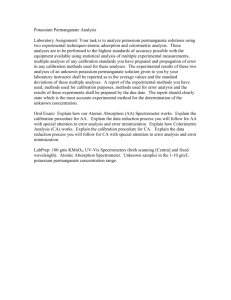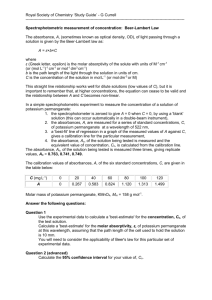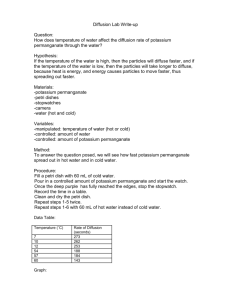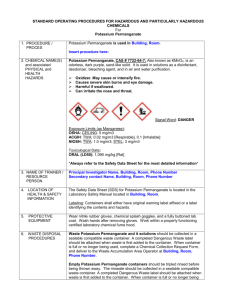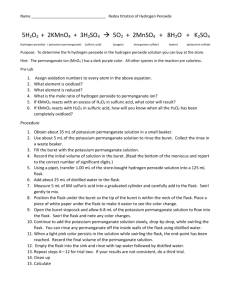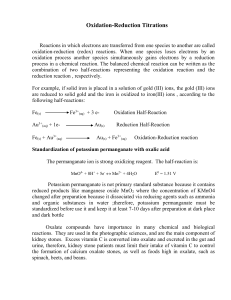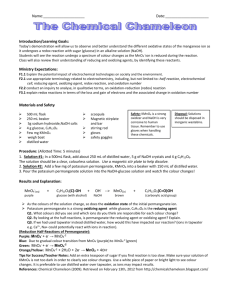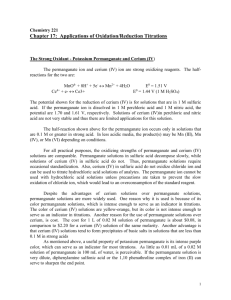Reaction of Potassium permanganate.
advertisement
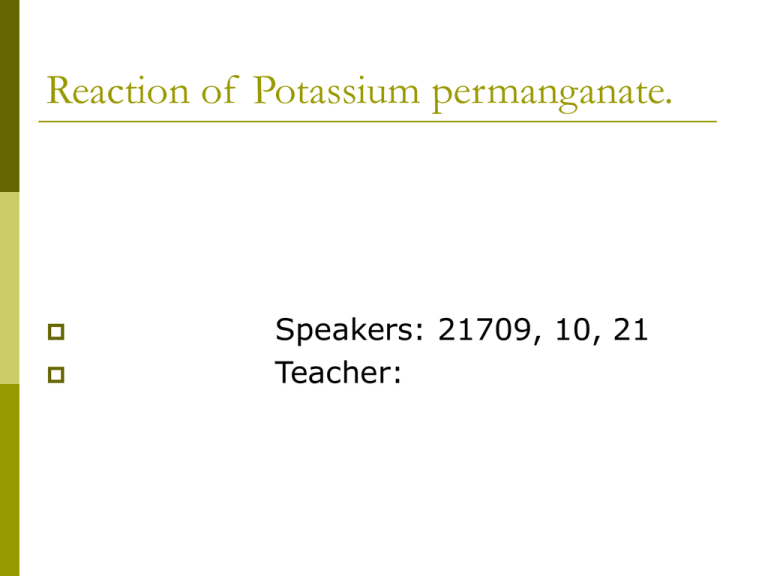
Reaction of Potassium permanganate. Speakers: 21709, 10, 21 Teacher: Background: oxidation-reduction reaction of Potassium permanganate 1. When the reaction happens under different pH value, different ionic products such as Mn2+, MnO2, MnO42are produced. 1. Each ion can be produced under acidity, neutrality, and alkaline Objectives Observe the products of the oxidationreduction reaction of Potassium permanganate which occurs under different pH environment and establish a model. 2.Measure the proportion of distinct ions when reaction happens under different conditions from acid to alkali condition. 3. Use various organic matters to react with Potassium permanganate and detect the product. 1. Experiment 1: Observation 1.Prepare 0.01M of Potassium permanganate(dissolved in water) 2.Prepare 3% hydrogen peroxide 3.Take 3ml of Potassium permanganate and add it to 10-ml solutions of different pH values. 4. Slowly drop hydrogen peroxide into it and observe the color change. Experiment 2: Qualitative analysis 1.Prepare 0.01M Potassium permanganate aqueous solution. 2. Prepare 3% hydrogen peroxide. 3. Prepare 0.01M 0.1M 1M Sodium hydroxide aqueous solution. 4. Prepare 0.5M 0.05M 0.005M sulfuric acid aqueous solution. 5. Use pH meter to show the pH value of the two solutions. 6. Add 2mL Potassium permanganate aqueous solution into 30mL Sodium hydroxide aqueous solution. 7. If there are precipitations, put the solution into centrifuge and take the upper layer solution to run the spectrophotometer. 8. See the highest absorption peak and check if there are manganese dioxide and MnO42- coexist. 9. Back to step 4 and add 2mL Potassium permanganate aqueous solution into 30mL sulfuric acid aqueous solution. 10. Put the solution into the spectrophotometer 11. See the highest absorption peak and measure the ratio of Mn2+. Experiment 3: Organic matters' reaction 1. Prepare 0.01M Potassium permanganate 2. Add 3mL into the organic matter under acid condition 3. If the oxidation-reduction reaction occurs, move the reaction to neutrality and alkaline condition. Results In first experiment, we saw the solution turn to be colorless under pH 5. But under pH 7,we got the brown precipitate called manganese dioxide. And we got more and more manganese dioxide when it was under pH 8,9 and 10 In second experiment, we find that if we add Potassium permanganate aqueous solution into sulfuric acid aqueous solution (pH 0~2)and drop 3% hydrogen peroxide into it slowly, the color of the solution will turn to orange first and then turn to be colorless ;on the other hand, if we add Potassium permanganate aqueous solution into Sodium hydroxide aqueous solution (pH12~14)and drop hydrogen peroxide into it,the solution’s color will turn to dark green. Discussions 1. when we put the same concentration and amount of Potassium permanganate aqueous solution and hydrogen peroxide into each buffer, we find that the solution produces more and more precipitate(MnO2),so we predict that Mn2+ and MnO2 might coexist. 2. Since we find that the solution which turns to dark green in the second experiment produces some precipitation at the bottom , we want to make our experiment more accurate to make sure whether MnO42- and MnO4 can coexist. If that is correct, we can control the pH value, and then use spectrophotometer to find the ratio between MnO42- and MnO2 in different pH value. Future prospect 1. By the spectrophotometer, we expect to know all the ratio of ion under the different pH value. 2. Find out how the pH value affects MnO4-'s oxidation force. 3. Figure out the pH border of Mn2+,MnO2,and MnO42-.
